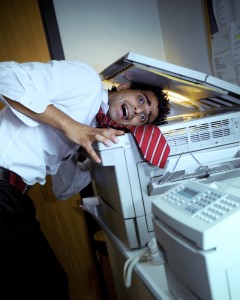There’s nothing funny about getting injured at work, which is why humor can help!
A recent study found that there is a positive correlation between employee happiness and workplace safety: the happier the employees were, the safer the work environment tended to be. 
Of course, this could also be a chicken-and-egg relationship: maybe people are happier when they feel safe? I know I’d be happier if I didn’t have to worry about my own safety every day!
But this relationship does make sense to me. When employees are more engaged, more inspired, or just plain happier, chances are they are less stressed out, more communicative, more creative and more alert. People who actually want to be at work on a Monday morning are, I think, going to be more aware of their environment and more conscientious about their working environment and the well-being of their coworkers.
But beyond the general “feel good”, morale-boosting humor factor, I believe there are several ways humor in the workplace can create a safer work environment:
Humor is an effective stress buster
Stress is totally in the eye of the beholder – it’s not the events themselves that create stress, it is totally our interpretation of the events that causes us stress. And since humor is an effective way of changing how we look at things, tapping into our sense of humor can reframe day-to-day challenges and help us see problems in a more grounded, realistic light. Humor, in other words, helps us keep molehills as molehills long before they threaten to erupt into mountains.
We also need to remind ourselves that when a stressful situation happens, we have 100% control over how we react to that situation. Humor helps us gain a sense of control over our emotions by allowing us to choose a more positive reaction.
So what does all this have to do with safety? A lot, I’d suggest.
Stressed-out people don’t think clearly, tend to make more mistakes, and often do things in a hurry—all of which can lead to more accidents in the workplace.
Simply put: stress can blind us to the hazards around us; whereas humor can enlighten us by helping us keep cool, calm and collected.
Humor can help you deliver your safety messages more effectively
To communicate effectively, you need to stand out from the herd to be heard. Humor is an effective tool that can help your messages stand out from all the noise, keep people awake, and help people remember the safety messages for a long time. (There is, after all, a reason that 70% of all award-winning ads incorporate humor in them.)
Humor is a reframing tool, so it can be used to help people see your safety messages in new ways. And because smart humor appeals to both logic and emotion, humor is incredibly effective at doing what any good communication strategy needs to do – connect the brain to the heart.
Some people worry that humor might trivialize a serious message, but with a little creative thought, this needn’t be a concern. Any safety message, no matter how serious, can benefit from a little levity thrown into the mix.
In fact, I’d go so far as to say that if you are serious about safety in your workplace, then you better think about getting serious about your use of humor!
Humor can make your (sometimes) dreadfully boring safety meetings come to life 
I’ve been there—I drew the shortest straw, and thus had to represent my department at the mandated monthly safety meetings. In other words, I, like most of the other folks at the table, HAD to be there.
But wouldn’t it be better if people WANTED to be at your safety meetings? If they WANTED to be fully present? If they WANTED to participate and share their ideas?
Meetings don’t have to suck the soul out of everybody attending them to be effective. You really can make meetings more productive and have more fun at the same time.
Adding some humor to the meeting agenda, having a fun ritual to kick off or end the meeting, including door prizes in the meeting, opening up your safety meeting with a funny safety-related quote or showing humorous safety videos, are all simple but effective ways of bringing a little fun and energy into any safety meeting
HA + HA = AHA! Humor sparks creative thinking
There is, in fact, a huge correlation between humor and creativity. Humor in the workplace reduces stress, promotes lateral thinking, and, again helps us see things in a different way. Both humor and creativity are about looking at your challenges and seeing them in a fresh, new way.
So if you need to get creative about solving some of your safety issues, creative in terms of how you secure more money out of the old budget, or you need to get more creative with your safety messages, then, once again, a little humor goes a long way.
Humor in the workplace builds trust and fosters more open, closer working relationships
This has been born out in study after study–teams that laugh together, work well together.
If you are part of a team where there is a high level of trust, and positive, supportive communication with each other, then it is that much easier to offer feedback and call each other out when someone is doing something in an unsafe manner.
Humor can help us disagree with each other, without being disagreeable, so no matter how touchy a safety issue is, humor helps build the kind of working relationship between co-workers where it’s easy to be open and honest with one another.
Copyright 2010. Michael Kerr, mike@mikekerr.com
For great ideas, inspiration and a dash of humor, sign up for my weekly Humor at Work e-zine at www.mikekerr.com
Michael Kerr is a Hall of Fame business speaker and the author of eight books, including The Humor Advantage, The Jerk-Free Workplace, and Hire, Inspire and Fuel Their Fire.



